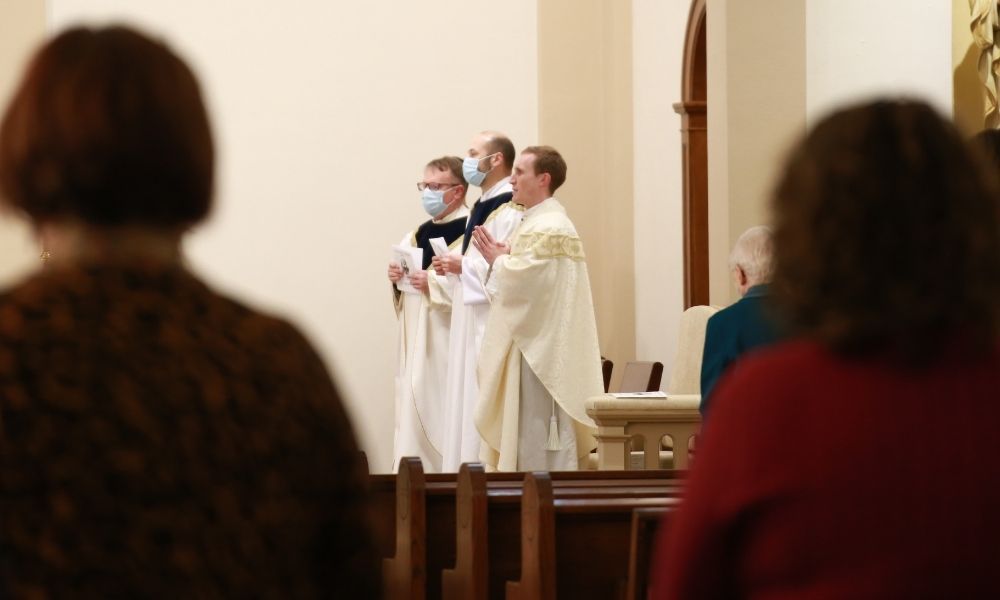The week of February 21st holds additional meaning for Heritage Month 2022. It is Homecoming Week and a time to celebrate St. John Henry Newman, Newman University’s namesake.
It is a time filled with popular activities, including an opportunity to celebrate the birth of St. Newman with a special Mass in St. John’s Chapel on the Newman University campus. The Mass was held on Feb. 22 and celebrated by Fr. Adam Grelinger, Fr. Chad Arnold, and Fr. Michael Simone.

The Newman Troubadours, under the direction of Deanne Zogleman and accompanist Carole Pracht, provided inspiring music for the service.
In his homily, Fr. Grelinger, university chaplain, gave an uplifting message which featured St. Newman, St. Maria De Mattias, and insights into how our heritage should be celebrated and challenge us.
Fr. Adam Grelinger Homily, Mass of St. John Henry Newman
“In Heritage Month we look back to remember who we are.
We look back to the life and motivations and works of St. Maria De Mattias.
We look back to the life and thought of St. John Henry Newman.
We look back to see the sparks that got us going.
We look back to see who we are, and who we strive to be.
But of course, we can’t only look back. The Adorers aren’t just a small group of teaching women in Italy anymore. The university ‘business’ of today has changed a great deal from when Newman wrote the Idea of a University. We aren’t a boarding school or Sacred Heart College anymore. It’s not 1933; it’s 2022.
We have changed. The world has changed.
We may recall a famous quote of St. Newman:
‘In a higher world it is otherwise, but here below to live is to change, and to be perfect is to have changed often.’
It comes from his great work ‘An Essay on the Development of Christain Doctrine.’
Doctrines develop through time because they are like living organisms or like rivers — they only gradually reveal their fullness, their real potential. A simple mountain stream in Colorado isn’t the fullness of the Arkansas river. The sapling isn’t the fullness of the Oak Tree. We don’t really know them until their facets are all worked out. Rivers broaden and deepen. Trees grow new and larger branches.
Doctrines and ideas are complex.
They require time and a community of discourse — in a lively interaction of questions and ideas and tangents — to work out, to actualize more and more of their potential.
It is in this understanding that Newman says, ‘here below to live is to change, and to be perfect is to have changed often.’
Changing, that is developing, is a sign of life for a doctrine and a tradition. If something isn’t changing, that is developing, interacting with changing circumstances and new minds, then the tradition is, in a way, dying. It becomes a fact of history. The river that isn’t flowing stagnates and is going to dry up. The tree that doesn’t produce new leaves in spring has probably died.
A doctrine and a tradition stay alive through the lively play of minds in study, dialogue, experience, experimentation, and argumentation.
Doctrine also stays alive by being rooted in the foundational truths. Some things are fixed. They are anchor points so the dialogue doesn’t get unhinged. Certain things have been revealed, like the doctrine of the Holy Trinity. The doctrine of One God while three persons has been fixed through Christian history, but the depth and breadth of understanding of the doctrine has developed through much prayer and dialogue.
An anchored change, or a rooted change.
I think such an idea can apply to us, here at Newman University as well. We are the inheritors of a tradition, a heritage, and of doctrine. St. Maria, the Adorers, St. Newman, the Catholic Faith, excellence in various academic fields by hundreds of faculty and students through our history, and much more.
We have received a tradition. We have received a heritage. But we can’t receive it as just facts of the past, or fixed principles we are stuck with.
A great force behind Heritage Month should be that we look back again at the gift we have received and the community we are blessed to have entered into, that stretches back past all of our lives. We look back at the original impetuses that inspired St. Maria & St. Newman. What inspired the founders of the original boarding school and what inspired those who came after who took it to become a junior college, and eventually come to be university.
But then we engage with it, we put it in the play between lively minds. We claim it. It is ours, not exclusively because those who came before are still part of it, but it is ours too.
A Heritage challenges us in two ways:
- We are challenged to know what we have inherited. To know our founders, what motivated them, what they said and did. We are challenged to know Catholic doctrine and what it means to be Catholic. We are challenged to know the what and why of our mission, values, and code. Challenged to know our academic disciplines well.
- And we are challenged to engage with the needs, difficulties, and interests of today. Not stuck in the past, but inspired by what came before to speak to today. Today’s circumstances. Our lives. Impending problems. New interests. Our interests. It will take on new forms. Trees grow new limbs, and dead branches need to be removed. Rivers broaden and take new turns.
Gustav Mahler said, ‘Tradition is not the worship of ashes, but the preservation of fire.’
Like a torch handed on to us by which we can see our present circumstances, but we still have to choose where to go and what to shed the light on.
May Heritage Month be a special time for us to look back to appreciate what has come before. What we have inherited. But then let it continue to live in us, be alive in us, in our present circumstances, in our present community, in our current world.
‘Here below to live is to change, and to be perfect is to have changed often.’
For us and for our Heritage (and even when we are thinking about transforming society), if our Heritage is living then it will develop. It will grow. It will unfold, it will become more fully displayed. In this way it will change. The perfection of a tree is its full maturity which requires constant change and growth, not to be a different kind of organism, but to be fully itself.
Rooted in our mission, core values, and code. Inspired by those who came before. We take up the mantle, become part of the Heritage. We claim it. Then it will develop in us. It will come to greater flourishing in us, if we let it. And we will then pass it off to the next class, the next generation, like a bright, lively torch, a lively flame.”





